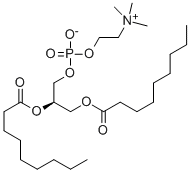L-A-PHOSPHATIDYLCHOLINE, DIOCTANOYL
- CAS NO.:19191-91-4
- Empirical Formula: C24H48NO8P
- Molecular Weight: 509.62
- MDL number: MFCD00082429
- SAFETY DATA SHEET (SDS)
- Update Date: 2024-10-23 13:36:13

What is L-A-PHOSPHATIDYLCHOLINE, DIOCTANOYL?
The Uses of L-A-PHOSPHATIDYLCHOLINE, DIOCTANOYL
08:0 PC (1,2-dioctanoyl-sn-glycero-3-phosphocholine/C8PC) has been used as a substrate to study the analytical capabilities of several methods to determine water soluble phospholipids containing choline (wCh-PL) and also to study the behavior of the its analytical signal in a synthetic serum matrix (data-Trol). It may also be used as a bicellar model to study their phase behavior and to form a lipid film to study its effect on P-glycoprotein′s (P-gp′s) activity/to compare its effect with TWEEN?80 and Cremophor?EL.
What are the applications of Application
1,2-Dioctanoyl PC is a synthetic substrate for PC-PLD and sPLA2
Definition
ChEBI: 1,2-dioctanoyl-sn-glycero-3-phosphocholine is a 1,2-diacyl-sn-glycero-3-phosphocholine in which the acyl groups at positions 1 and 2 are specified as octanoyl. It is a 1,2-diacyl-sn-glycero-3-phosphocholine and an octanoate ester.
General Description
The list of Phosphatidylcholine products offered by Avanti is designed to provide compounds having a variety of physical properties. Products available include short chain (C3-C8 are water soluble and hygroscopic), saturated, multi-unsaturated and mixed acid PC′s. All of the products are purified by HPLC, and special precautions are taken to protect the products for oxidization and hydrolysis.
Biochem/physiol Actions
Phosphatidylcholine?(PC) can form a hydrophobic surface in the mucus by acting as a surfactant to inhibit the penetrance of bacteria.
Properties of L-A-PHOSPHATIDYLCHOLINE, DIOCTANOYL
| storage temp. | -20°C |
| solubility | DMF: 20 mg/ml; DMSO: 20 mg/ml; Ethanol: 30 mg/ml; ETOH:PBS (pH 7.2)(1:1): 0.5 mg/ml |
Safety information for L-A-PHOSPHATIDYLCHOLINE, DIOCTANOYL
| Signal word | Danger |
| Pictogram(s) |
 Skull and Crossbones Acute Toxicity GHS06  Health Hazard GHS08 |
| GHS Hazard Statements |
H302:Acute toxicity,oral H315:Skin corrosion/irritation H319:Serious eye damage/eye irritation H331:Acute toxicity,inhalation H336:Specific target organ toxicity,single exposure; Narcotic effects H351:Carcinogenicity H372:Specific target organ toxicity, repeated exposure H412:Hazardous to the aquatic environment, long-term hazard |
| Precautionary Statement Codes |
P201:Obtain special instructions before use. P273:Avoid release to the environment. P302+P352:IF ON SKIN: wash with plenty of soap and water. P308+P313:IF exposed or concerned: Get medical advice/attention. |
Computed Descriptors for L-A-PHOSPHATIDYLCHOLINE, DIOCTANOYL
New Products
(S)-3-Aminobutanenitrile hydrochloride 4-Methylphenylacetic acid N-Boc-D-alaninol N-BOC-D/L-ALANINOL Tert-butyl bis(2-chloroethyl)carbamate 3-Morpholino-1-(4-nitrophenyl)-5,6-dihydropyridin- 2(1H)-one Furan-2,5-Dicarboxylic Acid Tropic acid 1-Bromo-3,5-Di-Tert-Butylbenzene S-2-CHLORO PROPIONIC ACID ETHYL ISOCYANOACETATE 2-Bromo-1,3-Bis(Dimethylamino)Trimethinium Hexafluorophosphate 4-IODO BENZOIC ACID 3-NITRO-2-METHYL ANILINE 1-(2,4-DICHLOROPHENYL) ETHANAMINE (2-Hydroxyphenyl)acetonitrile 4-Bromopyrazole 2-(Cyanocyclohexyl)acetic acid 4-methoxy-3,5-dinitropyridine 1-(4-(aminomethyl)benzyl)urea hydrochloride 2-aminopropyl benzoate hydrochloride diethyl 2-(2-((tertbutoxycarbonyl)amino) ethyl)malonate tert-butyl 4- (ureidomethyl)benzylcarbamate Ethyl-2-chloro((4-methoxyphenyl)hydrazono)acetateRelated products of tetrahydrofuran








You may like
-
 08:0 PC CAS 19191-91-4View Details
08:0 PC CAS 19191-91-4View Details
19191-91-4 -
 08:0 PC CAS 19191-91-4View Details
08:0 PC CAS 19191-91-4View Details
19191-91-4 -
 1975-50-4 98%View Details
1975-50-4 98%View Details
1975-50-4 -
 2-HYDROXY BENZYL ALCOHOL 98%View Details
2-HYDROXY BENZYL ALCOHOL 98%View Details
90-01-7 -
 2-Chloro-1,3-Bis(Dimethylamino)Trimethinium Hexafluorophosphate 221615-75-4 98%View Details
2-Chloro-1,3-Bis(Dimethylamino)Trimethinium Hexafluorophosphate 221615-75-4 98%View Details
221615-75-4 -
 61397-56-6 CIS BROMO BENZOATE 98%View Details
61397-56-6 CIS BROMO BENZOATE 98%View Details
61397-56-6 -
 14714-50-2 (2-Hydroxyphenyl)acetonitrile 98+View Details
14714-50-2 (2-Hydroxyphenyl)acetonitrile 98+View Details
14714-50-2 -
 118753-70-1 98+View Details
118753-70-1 98+View Details
118753-70-1